Vitex Trees (Chaste Trees): Types, Flowers, Leaves, Care (Pictures)
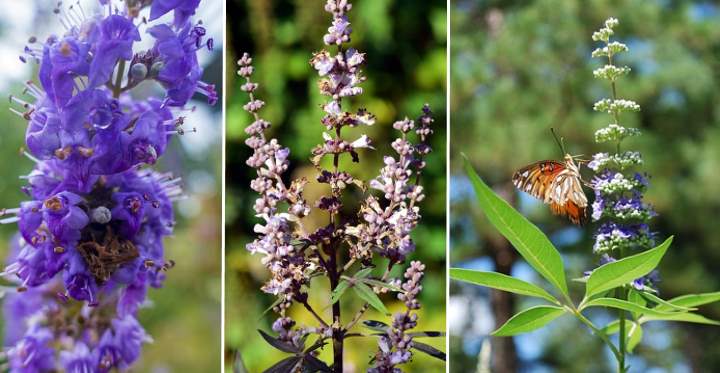
Vitex tree (also named chaste tree) is a large type of shrub or small tree with attractive spikes of lavender-colored flowers that bloom in summer. Vitex shrubs and trees are commonly called the chaste tree, chasteberry, monk’s pepper, or simply vitex. Vitex trees grow best as tall flowering shrubs in warm, sunny climates. In colder climates, chaste trees grow as small as perennial shrubs.
Chaste trees (Vitex agnus-castus) have many characteristics that make them desirable garden shrubs. Apart from the clusters of small violet flowers, these plants have aromatic grayish-green, lanceolate leaves. The large deciduous shrubs have a vase-shaped growth that spreads upward and outward. This attractive landscape plants attracts butterflies and pollinators while in bloom during summer and fall.
This article is a complete guide to vitex trees. Descriptions and pictures of vitex trees (chaste tree) will help identify the best vitex tree cultivars to plant in your garden landscape. At the end of the article, you’ll find some helpful tips on caring for this shrub-like tree.
Vitex Trees Vs. Vitex Bush
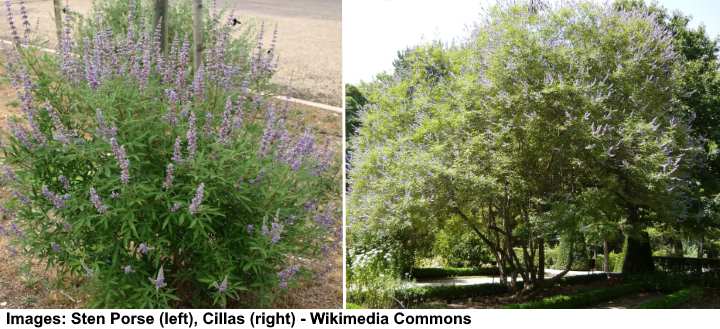
Vitex is a woody plant that can grow as a shrub (left) or as a multi-stemmed shrubby tree (right)
The woody plant Vitex agnus-castus grows as a large multi-stemmed shrub. Although referred to as the vitex tree or chaste tree, the vitex plant generally grows as a sizeable bushy shrub. But in warmer climates, vitex can grow as a small multi-trunked tree. Typically, vitex bushes grow between 3 and 15 ft. (1 – 4.5 m) tall, and vitex trees grow between 15 and 20 ft. (4.5 – 6 m) tall.
Because vitex bushes die back to the ground in colder climates, they only grow as small shrubs.
Vitex Tree Facts
Vitex agnus-castus is an aromatic shrubby plant in the family Lamiaceae. This means that chaste trees (vitex) are related to herbs such as mint, sage, thyme, and lavender. The Vitex genus of flowering plants is considered as species of tropical or sub-tropical woody shrubs. Some species of Vitex also grow in temperate zones.
Vitex trees grow best in USDA zones 7 through 9. In warmer climates, the large shrub can grow up to 15 ft. (4.5 m) tall and, as a tree, up to 20 ft. (6 m) tall. In zones 5 and 6, the shrubby plant experiences winter die-back. However, frost rarely affects the roots, and vitex bushes come back to life the following spring. Heavy pruning in temperate climates promotes flowering and continuous blooming.
Vitex agnus-castus is said to have medicinal properties and was used as a tonic for male and female reproductive systems.
Many of the vitex plant’s common names refer to its common herbal uses—for example vitex is also named chaste tree and monk’s pepper. Other names for vitex include lilac chastetree, hemp tree, Indian spice, Texas lilac, Abraham’s balm, and chasteberry.
Vitex Agnus-Castus Tree Leaves
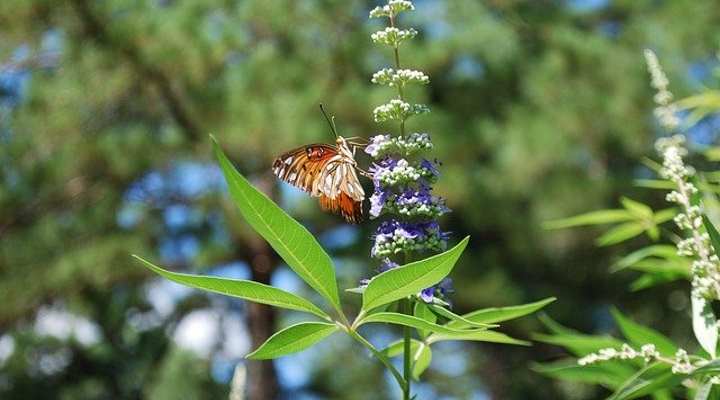
Leaves and flower of vitex tree
Vitex tree leaves are aromatic palmate compound leaves, each containing five to seven leaflets. The long vitex leaflets grow oppositely on the stems. Vitex has lance-shaped leaves that can grow between 6” and 8” (15 – 20 cm) long. The foliage color is gray-green on the upper side and gray on the underside. However, some species of Vitex have spectacular leaves with purple undersides.
Chase trees are deciduous trees, meaning that they lose their leaves in the fall. Before vitex leaves drop, they turn a rusty yellow-orange color.
Looking at pictures of vitex tree leaves, you’ll notice that they resemble cannabis plants. The palmate leaves with long pointed leaflets are one reason why vitex trees also have the name hemp trees.
Crushing chaste tree leaves releases aromatic essential oils. Some people say that Vitex agnus-castus leaves give off a strong earthy scent with an aroma reminiscent of sage.
Vitex Tree (Chaste Tree) Flowers

Vitex tree flowers are lilac-lavender, pink or white
Chaste trees produce spikes of fragrant lilac, white, pink, or lavender flowers when they bloom in late summer. Vitex tree flowers grow in slender, conical flowering spikes called panicles. The clusters of tiny pastel-colored flowers are small tube-like flowers called corollas. These scented flowers give off distinct peppery aromas.
The most common color of Vitex agnus-castus flowers is bluish-purple or light lavender. However, some vitex plants bloom with pink or white flowers. For example, the ‘Silver Spire’ chaste tree has flowering spikes of white flower clusters. The Vitex agnus-castus ‘Salina’s Pink’ and the dwarf vitex shrub ‘Pink Pinnacle’ bloom throughout the summer with soft pink fragrant flowers.
Many people say that pictures of vitex flowers resemble panicles on butterfly bushes.
After vitex trees finish blooming in fall, clusters of small black berries appear. These small vitex fruits resemble black peppercorns. With their peppery taste and supposed effect on suppressing desire, the vitex tree also goes by the name monk’s pepper.
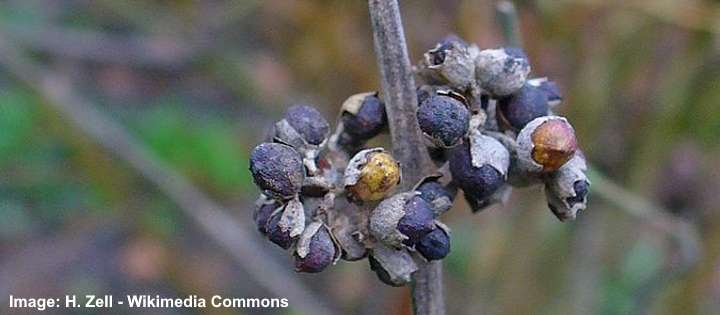
The fruits of vitex tree look like black peppercorns
Types of Vitex Trees (With Pictures)
Let’s look in more detail at some of the best examples of chaste trees that you can plant in your backyard to add summer color to your garden landscape.
Shoal Creek (Vitex Agnus-Castus ‘Shoal Creek’)
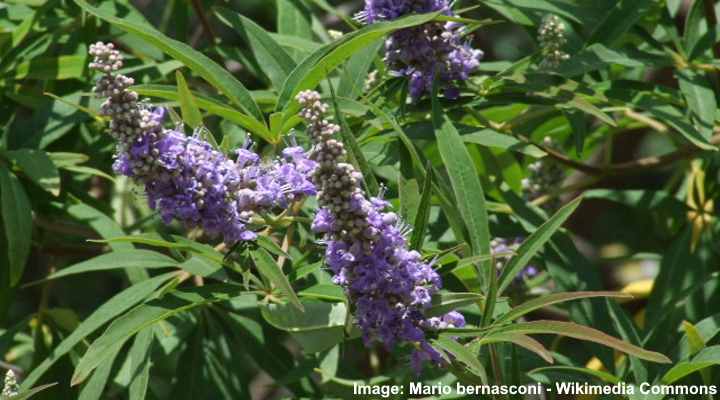
Vitex ‘Shoal Creek’ is also marketed under the name ‘Texas Lilac’
‘Shoal Creek’ chaste trees are small to medium-sized shrubs with purple or lavender-colored flowers. This multi-stemmed shrub has dense foliage made up of large grayish-green palmate hemp-like leaves. The stunning feature of ‘Shoal Creek’ vitex is the long flowering spikes that grow 1 ft. (30 cm) long.
‘Shoal Creek’ vitex trees grow between 10 and 15 ft. (3 – 4.5 m) tall. This vitex cultivar doesn’t require pruning in warmer climates and will grow as a bushy shrub or can be trained as a small multi-trunked tree. Pruning this vitex tree cultivar is helpful to limit its tall growth.
In colder climates, ‘Shoal Creek’ grows as a small perennial shrub. The aromatic shrub dies to the ground in winter. However, in spring, the plant regrows, and this fast-growing vitex plant can grow between 4 and 7 ft. (1.2 – 2.1 m) in a growing season.
As with most vitex trees, the ‘Shoal Creek’ benefits from regular pruning. The best time for pruning branches to encourage dense, bushy growth is in winter or early spring. Pruning also helps to boost the number of flowers that bloom throughout the summer.
The best growing conditions for this vitex tree are in full sun, protected from the cold. Plant chaste trees in loose, well-draining soil and keep the ground moist. Once established, this vitex cultivar is a low-maintenance plant that is tolerant of drought. ‘Shoal Creek’ chaste trees grow best as specimen plants, small bushy trees, large shrub borders, or foundation plantings.
‘Shoal Creek’ vitex trees are sometimes marketed under the name ‘Texas Lilac’. Horticulturalists from Texas A&M University have developed 3 types of chaste trees that are called ‘Texas Superstars’. They include ‘Shoal Creek’, ‘Montrose Purple,’ and ‘LeCompte’ – all marketed as ‘‘Texas Lilac.’ These varieties have larger and more attractive spikes of flowers compared to the old vitex varieties.
Alba Chaste Tree (Vitex Agnus-Castus ‘Alba’)
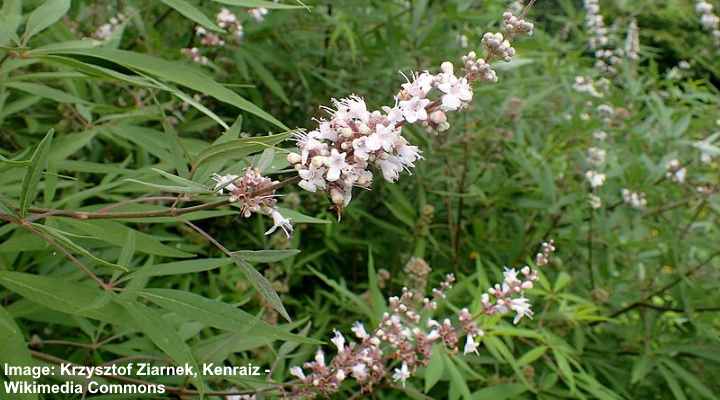
Alba chaste tree is a large shrub with white flowers and large palmate compound leaves
The ‘Alba’ chaste tree is a large shrub that blooms in summer with attractive white flowers. The characteristics of this ornamental tree are its white panicles that give off peppery scents. ‘Alba’ vitex leaves are palmate compound and have an earthy fragrance when crushed. Also, small black fruits develop on the tree in late summer and fall.
‘Alba’ vitex trees grow between 10 and 15 ft. (3 – 4.5 m). The cultivar grows as a large multi-stemmed shrub or small tree. ‘Alba’ vitex trees have a vase-shaped growth with a rounded crown. As with all vitex trees, large palmate compound leaves help identify this tree. Its white flowers are relatively unusual among Vitex agnus-castus cultivars.
‘Alba’ chaste shrubs are fast-growing plants, ideal for cottage gardens, specimen trees, or lining driveways.
Blue Diddley Chaste Tree (Vitex Agnus-Castus ‘Blue Diddley’)
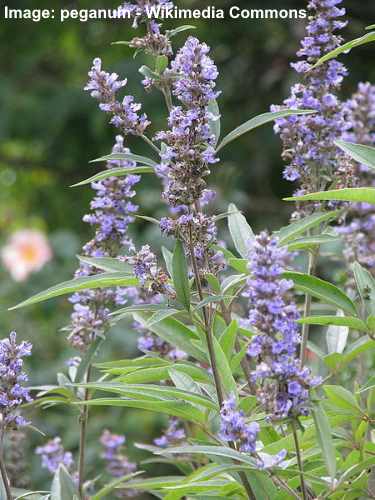
‘Blue Diddley’ vitex is a small flowering shrub ideal for compact gardens
‘Blue Diddley’ vitex bushes are dwarf shrubs with bluish-purple clusters of tubular flowers growing in a pyramidal shape. The stunning flowering spikes contrast nicely against the dark-green foliage. The compact flowering shrub has a naturally rounded growth habit that is ideal for small gardens or border plantings.
Dwarf Vitex agnus-castus ‘Blue Diddley’ grows between 3 and 6 ft. (1 – 2 m) tall. In northern climates, this fast-growing shrub grows as a dwarf perennial. In warm climates, the small vitex plant grows as a medium sized shrub or miniature tree.
To encourage regular flowering throughout the summer, deadhead the flowers. Like most types of vitex trees, this cultivar benefits from annual pruning in winter.
Silver Spire Chaste Tree (Vitex Agnus-Castus ‘Silver Spire’)
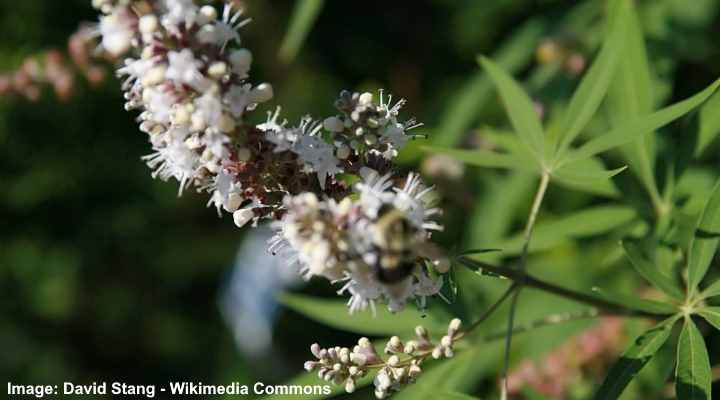
‘Silver Spire’ vitex is a shrub-like tree with white flowers
‘Silver Spire’ vitex trees are large flowering shrubs that grow as small trees in warmer climates. The characteristic feature of ‘Silver Spire’ chaste trees is their pointed flowering spikes made up of small tube-like white flowers. This vitex cultivar has palmate leaves that give off earthy sage scents when crushed.
‘Silver Spire’ chaste trees grow between 10 and 15 ft. (3 – 4.5 m). The shrub-like tree has a large, rounded crown formed from dense foliage made up of lance-shaped bluish-green leaflets.
Like all Vitex agnus-castus cultivars, the ‘Silver Spire’ variety has different growth habits in warmer and colder climates. In temperate regions, the plant is a multi-stemmed shrub that dies back to the ground in winter. The following spring, its growth recovers, and it grows as a small, rounded vitex bush with white flowers.
Abbeville Blue Chaste Tree (Vitex Agnus-Castus ‘Abbeville Blue’)
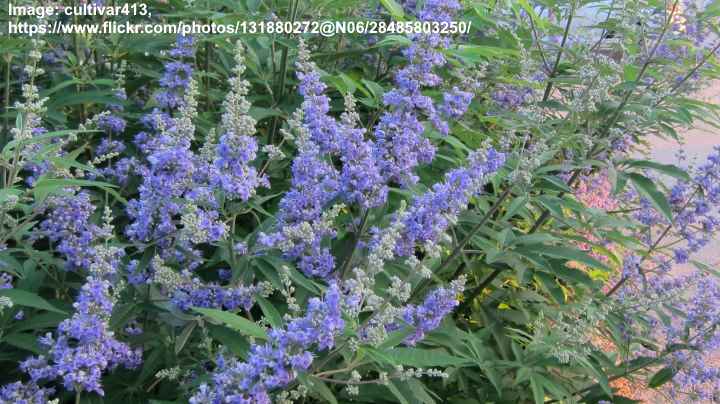
‘Abbeville Blue’ chaste tree is an attractive medium sized shrub with purple-blue flowers
‘Abbeville Blue’ vitex tree is a sizeable drought-tolerant shrub with long spikes of fragrant blue-purple summer flowers. This plant has arching lanceolate green leaves that make up a palmate compound leaf. The dark blue flowers contrast nicely with the light green foliage.
‘Abbeville Blue’ chaste trees grow between 10 and 20 ft. (3 – 6 m) tall.
Peacock Chaste Tree (Vitex Altissima)

Vitex Altissima is a large tree with white-pale purple flowers
The peacock chaste tree is a large type of vitex tree with whitish tubular flowers that are tinged with purple and growing on long spikes. Similar to most vitex trees, the peacock chaste tree has palmate leaves shaped like a hand, with the green oblong-lanceolate leaves taper to a point. After the tree finishes blooming, clusters of small black berry-like drupes appear.
The Vitex altissima tree grows between 40 and 65 ft. (12 – 20 m) tall. The peacock chaste tree has upright growth with foliage that grows as an unkempt conical shape.
Planting Vitex Trees
Vitex agnus-castus trees are fast-growing shrubs that thrive in loose, loamy soil that has excellent drainage. Before planting a chaste tree, ensure that the ground drains well. In addition to well-draining soil, you should plant chaste trees where they get plenty of sunlight. Vitex trees need to grow where they get at least six hours of sunshine daily to bloom through the summer.
How to Care for Vitex (Chaste Tree)
Chaste trees are low-maintenance landscape shrubs that flower year after year. Once established, you only have to water vitex trees during hot, dry periods. All you need to do is put a layer of mulch around the plant’s base. Vitex bushes don’t require fertilizer. The most crucial care requirement is to prune vitex trees every year.
How to Prune Chaste Trees (Vitex Agnus-Castus)
Pruning chaste trees (vitex) every winter helps to control growth, develop dense foliage, and encourage flowering. Deadheading—snipping off spent flowers—is another pruning method to make sure you get beautiful flowers all summer long. Chaste trees are forgiving when it comes to heavy pruning.
In winter, prune weak vitex stems and thin branches from the shrub’s center. You can remove most of the twiggy growth up to the main branches without harming the vitex plant. If you remove branches just above dormant buds, you will encourage new growth the following spring. You can even cut branches back to the main trunk if necessary.
You may need to prune vitex trees back to the ground in colder climates, such as USDA zones 5 and 6. Frost kills any growth above ground anyway, so you won’t damage the plant. The vitex tree roots withstand frost, and the shrub will regrow with remarkable pace the following spring.
Snip off dead flowers during spring and summer to encourage blooming through fall. Deadheading chaste tree flowers allows the tree to concentrate energy into growing new flowers rather than producing seeds.
Vitex Tree Problems
Root rot is the only major problem affecting chaste trees. The best way to avoid root rot is to plant the vitex tree in well-draining soil and only water it occasionally during hot weather. Chaste trees grow best in loose soil that is slightly moist.
Related articles:
- Types of Viburnum: Shrubs, Trees and Hedges
- Small or Dwarf Flowering Shrubs
- 18 Different Types of Bushes to Grow in the Yard
